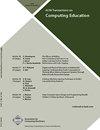留住计算机领域的黑人女性:对计算机专业持续发展干预措施的比较分析
IF 3.2
3区 工程技术
Q1 EDUCATION, SCIENTIFIC DISCIPLINES
引用次数: 1
摘要
尽管一直在努力实现计算机领域的多元化,但黑人女性在该领域的代表性仍然严重不足。鉴于黑人女性处于种族和性别身份的交叉点,有必要采取量身定制的方法来解决黑人女性在计算机领域面临的独特障碍。然而,由于计算机学生样本中的黑人女性通常太少,难以进行有力的统计分析,因此很难对旨在留住计算机领域黑人女性的干预措施的效果进行量化评估。利用由国家自然科学基金资助的 "拓宽参与计算(BPC)联盟 "约十年的学生调查反馈,我们使用回归分析定量研究了不同类型的干预措施与黑人女性坚持学习计算的意愿之间的联系,以及与其他学生(特别是黑人男性、白人女性和白人男性)的比较。通过这种比较,我们可以定量地探索黑人女性的需求与其他学生的不同和相似之处。我们发现,职业意识和教师指导是与黑人女性的计算机持续学习意向有显著统计学意义的正相关的两项干预措施。我们没有发现任何证据表明,增强信心或发展技能/知识与黑人女性的计算机学习坚持意愿相关,我们认为这是因为黑人女性必须高度投入和自信才能在大学里学习计算机。最后,我们的研究结果表明,许多旨在增加计算机领域女性人数的努力都侧重于满足白人女性的需求。虽然还需要进一步分析才能充分了解复杂的交叉身份在计算机领域的影响,但这项大规模的定量分析有助于我们了解黑人女性在计算机领域的细微需求。本文章由计算机程序翻译,如有差异,请以英文原文为准。
Retaining Black Women in Computing: A Comparative Analysis of Interventions for Computing Persistence
Black women remain severely underrepresented in computing despite ongoing efforts to diversify the field. Given that Black women exist at the intersection of both racial and gendered identities, tailored approaches are necessary to address the unique barriers Black women face in computing. However, it is difficult to quantitatively evaluate the efficacy of interventions designed to retain Black women in computing, since samples of computing students typically contain too few Black women for robust statistical analysis. Using about a decade of student survey responses from an NSF-funded Broadening Participation in Computing (BPC) alliance, we use regression analyses to quantitatively examine the connection between different types of interventions and Black women’s intentions to persist in computing, and how this compares to other students (specifically, Black men, white women, and white men). This comparison allows us to quantitatively explore how Black women’s needs are both distinct from—and similar to—other students. We find that career awareness and faculty mentorship are the two interventions that have a statistically significant, positive correlation with Black women’s computing persistence intentions. No evidence was found that increasing confidence or developing skills/knowledge was correlated with Black women’s computing persistence intentions, which we posit is because Black women must be highly committed and confident to pursue computing in college. Lastly, our results suggest that many efforts to increase the number of women in computing are focused on meeting the needs of white women. While further analyses are needed to fully understand the impact of complex intersectional identities in computing, this large-scale quantitative analysis contributes to our understanding of the nuances of Black women’s needs in computing.
求助全文
通过发布文献求助,成功后即可免费获取论文全文。
去求助
来源期刊

ACM Transactions on Computing Education
EDUCATION, SCIENTIFIC DISCIPLINES-
CiteScore
6.50
自引率
16.70%
发文量
66
期刊介绍:
ACM Transactions on Computing Education (TOCE) (formerly named JERIC, Journal on Educational Resources in Computing) covers diverse aspects of computing education: traditional computer science, computer engineering, information technology, and informatics; emerging aspects of computing; and applications of computing to other disciplines. The common characteristics shared by these papers are a scholarly approach to teaching and learning, a broad appeal to educational practitioners, and a clear connection to student learning.
 求助内容:
求助内容: 应助结果提醒方式:
应助结果提醒方式:


